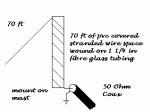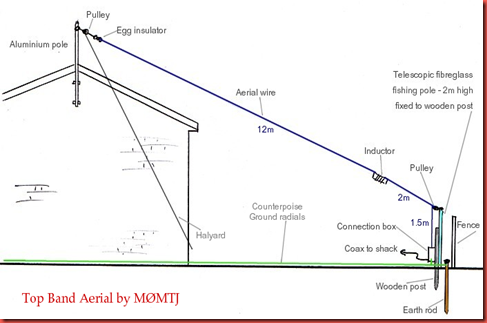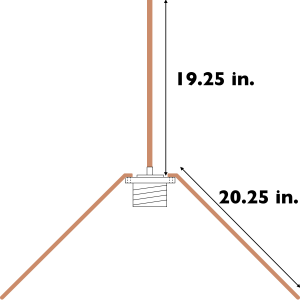Saturday, September 28, 2013
Matching the supply line to the antenna output of transmitter
Thursday, September 26, 2013
Amateur G5RV wire antenna
Amateur G5RV wire antenna in the picture with a size of 31 meters, it is the transition between the antenna option with long arms and a 54-meter antenna with an arm length of 27 meters. By wire antenna connected two-wire power supply with an impedance of 300 ohms (balun). Length of the power line should be 12.90 meters. This line acts as a power transformer. Towards the bottom of the feed point of the transformer is connected coaxial cable (Figure).
In the range of 28 MHz each half G5RV wire antenna has a length 3L / 2. Diagram of a shape of the antenna length 3L. In-phase excitation power gain compared to a conventional dipole is 1.8. In this range, the antenna G5RV works well. Since the length of the line is transforming 5L / 4, the wire antenna is in excellent agreement with the coaxial cable. At the points of "BB" impedance of about 60 ohms.
In the range of 21 MHz antenna length is slightly longer wavelength (L) of the range and reach the transformer is also a little longer than 3L / 4 matching any worse. Sizes do not allow you to work in a resonant mode, in spite of this antenna has a gain over a dipole is 1.8 dB, due to the fact that half the vibrator excited in phase. Diagram of the wire antenna in the same range as the two wave vibrator.
In the range of 14 MHz antenna matching is even worse than 21 MHz. At the points of "AA" very little resistance from the fact that the antenna has a size of 1.5L and is approximately 70 ohms. At these points there is a maximum current. Transforming line transforms the antenna impedance (70 ohms) to 200 ohms at points "BB". It is clear that such resistance is not suitable for connecting a coaxial cable with an impedance of 50 ohms ... 75. Reinforcement wire antenna in the range of about 2 - 2.2 dB.
In the range of 7 MHz G5RV wire antenna has a length 3L / 4 and the input impedance of 600 ohms. Length of transforming the line has 300 ohms resistance and the length of the 0.3L, as a result of the partial transformation of the 600 ohm resistance at the points of "AA" to the point "BB" is obtained impedance 150 ohm. Since the directional properties of the antenna wire in this range are similar pattern in a half-wave dipole and the win is no gain.
In the range of 3.6 MHz is a resonance antenna of its length in this range is 0.36 ... 0.47L. Antenna impedance is 150 ohms, the length of the transformer is equal to 0.15 ... 0.16L at points "BB" resistance is 100 ohm. In this range, the directional properties of even worse and the winning wire antenna gain, however.
From the above it follows that the written wire antenna (classical) English G5RV amateur radio should be used in conjunction with the tuner (for the transceiver). Changing the length of the line transformer and its impedance leads to improved coordination in some ranges and a deterioration in others.
A Practical Antenna for 160 Metres
Original article published by G3YCC
"This aerial is one I have used for top band (160 metres) - it was suggested to me by Alan G4ERZ, also of Hull.
It consists of 140 feet of insulated wire, the first half of which (70 feet) is space wound on an insulated tube.
- I used glass fibre tubing which was to hand, but PVC may be used also.
- My tube is 1 1/2 inches in diameter and about 5 feet 6 inches long.
- The turns are about 0.5 inches apart.
- The other 70 feet of wire acts as a loading wire and slope down from the top of the coil to near ground level.
- The system is coax fed to the base of the coil, with the shield or braiding going to earth.
It appears to work very well, apparently giving some horizontal and vertical polarisation.
One great advantage is the system can be tuned without having to lower the mast - by pruning the loading wire to resonate on the required part of the band.
Bandwidth is also good - mine is about 30 kHz either side of resonance.
I found the MFJ Antenna Analyzer MFJ-259 invaluable for this project, as well as many other experimental systems. Ensuring an efficient earth system will add to the effectiveness of the aerial I still have to improve my earth system, currently it consists of two 140 ft radials and connections to some buried guys stays.
Alan, G4ERZ, has a far more elaborate and efficient ground and his results prove what we all know - the ground (or earth system) is all important. He is a tremendous signal on 160 DX wise. He still gets the same band width as I do, though. I have worked a few DX stations with it since erecting it only a short while ago, and I think it has a lot to offer, especially for those of us blessed with relatively small gardens."
A short dipole for 80 meters
The antenna above has been described by Nadisha, 4S7NR and may be of interest to anyone wishing to get on 80M (3.5MHz) that have limited space available.
L1 is 12 feet. L2 also is 12 feet and the overall length is 48 feet.
The two loading coils are described as 67.83uH and can consist of 104 turns of insulated wire, wound over 3.5 inches. The coil diameter is not stated however. Maybe it will be a case for experimentation here.
An Inverted L for stealth with low(ish) visual impact
With a small back garden there is no way that I could accommodate an aerial for the 160m band that would be anything approaching full size. A full size dipole would be about 65 metres long and would need to be mounted at a very good height to be at its most effective. A full size vertical 1/4 wave would be about 37.5 meters tall. Impossible! Bending a 1/4 wave wire into an inverted L would still result in a very long wire - say 10 metres vertically and 27.5 metres horizontally. Still too large.
Full size top band antennas are big, far too big for my small plot, so I have tried a few different shortened 160m aerials. I really would prefer to use a balanced dipole not only for the radiation efficiency, but just as importantly for the lower noise on receive - like a ground mounted vertical aerial an inverted L can be rather noisy on RX. However I have to settle for a compromise, so shown in the drawings and photographs below is my current top band aerial, along with some previous experiments and ideas further down the page.
This incarnation of my Top Band aerial takes two forms. A compact Inverted L and, in its lower position, a less conspicuous sloping wire, shown below:
General layout of Top Band Aerial with fibreglass pole retracted to a height of 2 metres
Wire lengths are approximate: Inductor 5cm dia with approx 40 turns of 0.9mm e.c.w.
Building a 2m quarter-wave ground-plane antenna
The first antenna that you should consider building is the quarter-wave ground-plane antenna for the 2m band. They are very easy to build and will perform better than the antennas that come with most handhelds.
The quarter-wavelength, ground plane antenna is made up of one vertical element, called the driven element, and four radials. The radials make up the ground plane. An easy way to make this antenna is to use an SO-239 coax connector. The driven element is soldered directly to the center conductor, while the four radials are connected to the four holes in the connector’s flange. See the figure at right.
A simple 2m antenna can be made with an SO-239 connector and four short pieces of stiff wire.
Now, let’s calculate how long the elements should be. Since the wavelength of a radio wave is equal to 300/f (MHz), one quarter wavelength will be equal to 75/f (MHz). At 146 MHz, therefore, the length of the driven element is:
75/146 = .51 m
In practice, we have to make one more adjustment. Because a radio wave travels more slowly in a wire than it does in free space, the wavelength will actually be about 5% less in a wire than in free space. So, we multiply the wavelength in free space by .95 to get the length of the driven element:
.51m x .95 = .49m = 19.25 inches
The radials should be about 5% longer than the driven element. This isn’t really very critical, so if you make them 20.25 inches long, the antenna will work just fine.
You should make the elements out of a stiff wire. 12 AWG copper wire will work for experimentation purposes. Welding rod might be better for a more permanent antenna.
You need to solder the 19.25-in. driven element to the solder cup of the center conductor of the SO-239 connector. Attach the radials to the holes in the flange of the SO-239 connector with nuts and bolts. You can also use these nuts and bolts to mount the antenna to some kind of bracket. Bend the radials out to a 45-degree angle, connect a coax cable to it, and start having fun!
VHF antenna 144-146 mhz
The antenna in the figure is for the radio amateur band 144 - 146 MHz. Despite the fact that the antenna has five elements, it is not large, decent gain of 4 - 6 dB. This antenna for the 144 - 146 MHz is sufficient broadband and covers the entire two-meter amateur band. The antenna does not need a matching device, coaxial cable is connected directly to the vibrator. Antenna for the 144 - 146 can be made of wire with a diameter of 5 mm or pipes traverse can be wooden or made of the same material as the antenna elements. It is not advisable to use materials in combination aluminum / copper. The antenna does not need to set up, small inaccuracies sizes have virtually no effect on its performance. Who figured this antenna I do not know, but in this town it is used a lot of amateurs, dignity is a compact size. Easily fits in your car, can be used as a marching variant. Unfortunately more information about this antenna for the 144 - 146 MHz is not. Often use this antenna in a vertical polarization.
40 METER LOOP ANTENNA
If one is interested mostly only on 40 meter working, he can think of a loop antenna. It is simple and at the same time very effective. For best results, it should be made as square as possible. It should not be made more rectangular as the efficiency will suffer. The overall length of the antenna in feet can be found out by the formula 1005/f MHz. For a resonant frequency of 7.05 MHz the total length of the wire will be 142 feet 6 inches. For antenna wire 16 or 14 SWG wire can be used. Use 75 Ohms co-axial cable for the transmission line. The antenna should be kept at a hight of about 6 feet from the ground level.
If vertical polarisation is desired, feed the loop in the center of the vertical sides. This will give low angle radiation. If one desires horizontal polarisation, feed either to the horizontal sides.
The directivity of the loop antenna is broadside from the loop. So the antenna may be hung in such a way for maximum direction. This loop antenna has 2 DB gain over the dipole. It works well on 20 and 15 meter also with compromising results. For an experimenter, it is an antenna worth giving a trial.
Hentenna - An ADR Antenna
N. S. Harisankar / VU3NSH
Tel : +91 491 2576102, 9895741932
Hentenna is designed in 1970s by Tadashi Okubo JH1FCZ, Someya JE1DEU. They are 6 meter hams in Japan. In Japan, the word HEN means 'interesting, unusual, strange' etc. Ofcourse, it is a strange antenna and it is an Asymmetrical Double Rectangle (ADR) Loop Antenna. This system has more gain than an ordinary square loop and has the less impedance (nearby 70 ohms). It has two loop sections L1 and L2. The L1 section is the radiator part and the L2 is forming for matching and it helps the low angle radiation (10 to 13 degrees). Refer QST-1982 Feb (by JJ1UMS) and ARRL Antenna compendium vol. 5.
It was described for the first time in QST magazine in February 1982 by Koji Sugihara JJ1UMS (Page No. 16 -17). This antenna will produce a 5.1 dBd gain and with a 1.3:1 SWR with an amazing band width of 6.5 MHz. It can be upto 10 MHz bandwidth with 2:1 SWR. I started this antenna project, for VHF operation, using 3/8th aluminium tube and with a fine feed point movable plate section. The plate I have taken was a plexi glass of 15" x 2" and of 6 mm thickness. A SO239 socket was fixed at the centre of this plate for the cable connectivity (Refer photographs). Both ends of the feeds are connected with the 12 mm x 12 mm and 20mm long aluminium solid blocks with screw fixing holes. A 1 mm brass road is used to connect the above block sections to the SO239 socket, as a feed line.
The Hentenna Asymmetric size combinations are ‘lambda by 2’, ‘lambda by 6’ rectangle and feed point is ‘lambda by 10’ approximately. This antenna is not an omni and it is a bidirectional type. The HEN Part (Strange or Interesting) is as follows; If this antenna is fixed horizontally then it will produce a vertical polarisation !!! If it is fixed vertically the polarisation will be in horizontal. This character is explained by F.C.Judd (G2BCX) in 2 m antenna handbook in the ‘stacked skeleton slot array’ (page number 89-92). i.e., “The vertical slot is horizontally polarised and vice versa”. The skeleton slot system was developed by B Sykes - G2HCG of J-Beams Ltd. The radiation pattern is just like peanut shell.

Fig. 1. Hentenna - Horizontally mounted vertically polarized
Fig. 2. Feed point section of hentenna
When firing the antenna for the first time with the SWR meter, I fixed the movable section to ‘lambda by 10’ approximately, then I moved it up and down and took the readings (see the SWR graph given below). Then I changed the feed point to get a very low SWR with low and high power. I got a beautiful match at 25 cm from inner surface of the right side tube (element - loop 2) and this point gives a 6.5 MHz bandwidth with a low SWR of 1.2:1 !!! at a low height of 4 feet inside my QTH, I got VU2KOD repeater as 5 5 and 5 6 and all local stations around 10 kms. as 5 9 plus 20 dB. I done this project three months back with a search of unusual antennas. For testing and assembling this antenna my SWL Rejeesh also helped a lot. Make this bi-directional asymmetric double rectangle loop antenna and enjoy...
Fig. 3. Hentenna - SWR analysed chart
Fig. 4. Hentenna - SWR analysed chart
Fig. 5. Bidirectional radiation pattern of vertically polarised 145 MHz hentenna










